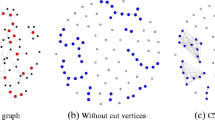Abstract
In this paper, we present an alternative multi-stage generalized upper bounds (GUB) based approach for detecting an embedded pure network structure in an LP problem. In order to identify a GUB structure, we use two different approaches; the first is based on the notion of Markowitz merit count and the second exploits independent sets in the corresponding graphs. Our computational experiments show that the multi-stage GUB algorithm based on these approaches performs favourably when compared with other well known algorithms.
Similar content being viewed by others
References
R.K. Ahuja, T.L. Magnanti, and J.B. Orlin, Network Flows: Theory, Algorithms, and Applications, Prentice-Hall, 1993.
B.M. Baker and P.J. Maye, “A heuristic for finding embedded network structure in mathematical programs,” European Journal of Operational Research, vol. 67, pp. 52-63, 1993.
J.J. Bartholdi, “A good submatrix is hard to find,” Operations Research Letters, vol. 1, pp. 190-193, 1982.
R.E. Bixby and R. Fourer, “Finding embedded network rows in linear programs I. Extraction heuristics,” Management Science, vol. 34, no. 3, pp. 342-376, 1988.
A.L. Brearley, G. Mitra, and H.P. Williams, “Analysis of mathematical programming problems prior to applying the simplex algorithm,” Mathematical Programming, vol. 8, pp. 54-83, 1975.
G.G. Brown and M.P. Olson, “Dynamic factorization in large-scale optimization,” Mathematical Programming, vol. 64, pp. 17-51, 1994.
G.G. Brown and W.G. Wright, “Automatic identification of embedded network rows in large-scale optimization models,” Mathematical Programming, vol. 29, pp. 41-56, 1984.
G.G. Brown and D.S. Thomen, “Automatic identification of generalized upper bounds in large-scale optimization models,” Management Science, vol. 26, no. 11, pp. 1166-1184, 1980.
G.G. Brown and W.G. Wright, “Automatic identification of embedded structure in large-scale optimization models,” in Computer-Assisted Analysis and Model Simplification, H. Greenberg and J. Maybee (Eds.), Academic Press: New York, 1981, pp. 369-388.
G.B. Dantzig and R.M. Van Slyke, “Generalized upper bounding techniques,” Journal of Computer and System Sciences, vol. 1, pp. 213-226, 1967.
S. Duff, A.M. Erisman, and J.K. Reid, Direct Methods for Sparse Matrices, Oxford University Press: Oxford-London, 1986.
D.M. Gay, “Electronic mail distribution of linear programming test problems,” Mathematical Programming Society, Coal, Newsletter, vol. 13, pp. 10-12, 1985.
F. Glover and D. Klingman, “The simplex SON algorithm for LP/embedded network problems,” Mathematical Programming Study, vol. 15, pp. 148-176, 1971.
H.J. Greenberg, “A functional description of analyze: A computer assisted analysis system for linear programming models,” ACM Trans. Math. Software, vol. 9, no. 1, 1983.
N. Gülpınar, G. Gutin, and G. Mitra, “Detecting embedded pure network structure using independent set algorithms,” Technical Report, TR/12/97, Brunel University, 1997.
N. Gülpınar, I. Maros, and G. Mitra, “Detecting pure embedded network structures in large-scale LP problems,” Technical Report, TR/20/96, Brunel University, 1996.
N. Gülpınar, G. Mitra, and I. Maros, “Creating advanced starting basis for large scale programs exploiting embedded network structures,” Technical Report, TR/04/98, Brunel University, 1998.
A. Hsu and R. Fourer, “Exploiting network structure for solving large scale linear programming models,” Working Paper, Jan. 1996.
S. Khanna, R. Motwani, M. Sudan, and U. Vazirani, “On syntactic versus computational views of approximately,” in Proceedings Symposium on Foundations of Computer Science, 1994.
H.M. Markowitz, “The elimination form of the inverse and its application to linear programming,” Management Science, vol. 3, pp. 255-267, 1957.
E. Messina and G. Mitra, “Modelling and analysis of multi-stage stochastic programming problems: A software environment,” European Journal of Operational Research, vol. 101, no. 2, pp. 343-359, 1997.
G. Mitra and M. Tamiz, “Alternative methods for representing the inverse of linear programming basis matrices,” in Recent Developments in Mathematical Programming, S. Kumar (Ed.), 1991, pp. 273-301.
V.T. Paschos, “A (δ/2)-approximation algorithm for the maximum independent set problem,” Information Processing Letters, vol. 44, pp. 11-13, 1992.
Author information
Authors and Affiliations
Rights and permissions
About this article
Cite this article
Gülpinar, N., Gutin, G., Mitra, G. et al. Detecting Embedded Networks in LP Using GUB Structures and Independent Set Algorithms. Computational Optimization and Applications 15, 235–247 (2000). https://doi.org/10.1023/A:1008791601215
Issue Date:
DOI: https://doi.org/10.1023/A:1008791601215




